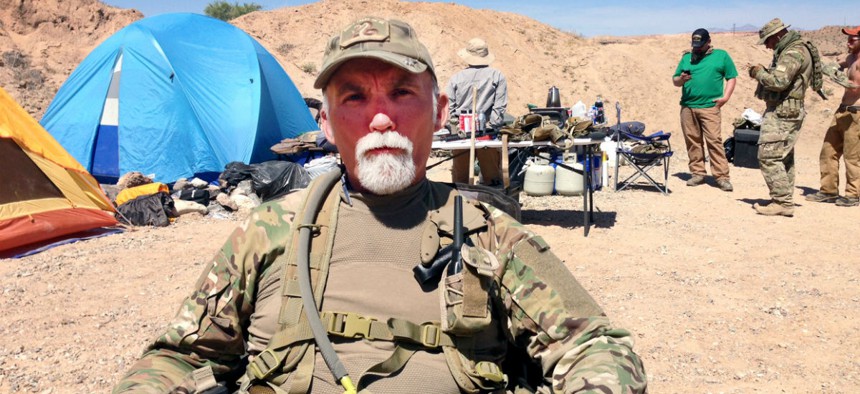
Jerry DeLemus heads a group of self-described militia members camping on Cliven Bundy’s ranch in Nevada in April 2014. Ken Ritter/AP file photo
One Year After Standoff With Armed Militia, BLM Employees Still Feel Vulnerable
Agency contends employee safety is its "No. 1 priority."
One year ago, ranchers and small government advocates flocked to Nevada and taught the federal bureaucracy a lesson.
What that lesson turned out to be is anybody’s guess. That is because the Bureau of Land Management has remained “tucked tightly in a fetal position” after armed militia members forced the agency to back down from its enforcement responsibilities, according to an employee group advocating for environmental workers in the public sector.
On April 12, 2014, protestors and some armed militiamen rallied in support of Nevada rancher Cliven Bundy. In what was intended to be the culmination of a longstanding battle between BLM and Bundy, the agency had rounded up all of the rancher’s livestock he had been illegally allowing to graze on federal land without paying the appropriate fees. The gathering of protestors led to a prolonged standoff, and eventually BLM released the cattle so the crowds would dissipate.
Public Employees for Environmental Responsibility said BLM has refused to disclose any documents relating to its decision-making process in regard to the incident, or how it plans to respond to similar situations in the future. BLM employees do not know what precautions were taken or how their safety will be ensured moving forward.
Additionally, PEER said, the situation with Bundy is unresolved. This could set a dangerous precedent as ranchers and other detractors feel “emboldened” to challenge the authority of federal agencies and regulations. If Bundy and a rag-tag crew of vigilantes with guns could get a federal agency to back down, what would stop others from doing the same?
The concern appears to have some merit. In July, the Homeland Security Department’s Intelligence and Analysis Office issued a report titled “Domestic Violent Extremists Pose Increased Threat to Government Officials and Law Enforcement.” The investigators said the “perceived victory by militia extremists” in the Bundy case would “likely inspire additional anti-government violence over the next year.”
In the months since the Bundy standoff, many Nevada ranchers have ignored BLM warnings to curb grazing activities while record droughts afflict the state and region. Now BLM employees are unsure where they stand, should new fights evolve.
Last year’s incident has “raised doubts in the minds of BLM managers whether their agency will support them if push comes to shove,” PEER said.
For its part, BLM maintains it gave PEER the documents the group demanded in a Freedom of Information Act request in March. As for Bundy, a spokeswoman conceded the situation is unresolved, but the agency is committed to finding a solution in the courts and away from danger.
BLM “remains resolute in addressing issues involved in efforts to gather Mr. Bundy's cattle last year and we are pursuing the matter through the legal system,” said Celia Boddington. “Our primary goal remains, as it was a year ago, to resolve this matter safely and according to the rule of the law."
Jessica Kershaw, a spokeswoman for the Interior Department, BLM’s parent agency, added the department regularly communicates with staff about their safety.
“Employee safety is always the department's No. 1 priority,” Kershaw said. “For the safety of our employees and their operations, management routinely reminds staff to remain situationally aware and to take prudent security precautions at all times.”
PEER remained unsatisfied with the documents and communication BLM provided, and has taken the agency to court to demand additional disclosures. On Thursday, PEER filed a summary judgment asking a judge to require BLM to release the documents.
“It should not take a federal lawsuit and months of foot-dragging to get an explanation for official actions splashed across the evening news,” PEER Executive Director Jeff Ruch said. “BLM can move forward only if it starts being candid with the public it is supposed to serve.”







